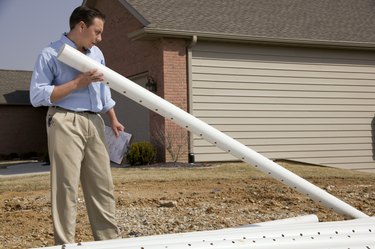Things You'll Need
Metal plumbing snake
Metal detector
Popsicle sticks
Twine

Many newer homes use PVC pipes for their plumbing needs. This is an improvement over metal pipes, because they cannot be corroded by rust. PVC pipes are made out of hard plastic called polyvinyl chloride. Get expert help locating them in your yard by calling a professional service or the 811 utility line. However, a professional service may cost around $60 per hour, and the 811 staff may not be able to locate your pipes. You can detect buried PVC water lines on your own by running a metal "snake" -- a common plumbing tool used to unclog leaks -- through your pipe. Then use a metal detector to see where the water line runs through your yard.
Step 1
Rent or buy an extra-long plumber's snake.
Video of the Day
Step 2
Insert the snake's cable into your PVC pipe, starting from a known location such as down your drain in your bath tub.
Step 3
Uncoil the snake cable until it encounters an obstruction.
Step 4
Go outside with the metal detector, and scan your yard with it until it encounters metal.
Step 5
Insert a Popsicle stick into the ground where your detector alerts you to the presence of metal.
Step 6
Scan the area surrounding the Popsicle stick marker by using the metal detector, surveying a 2-foot radius around the stick.
Step 7
Insert Popsicle sticks wherever your detector registers metal.
Step 8
Repeat this step around the Popsicle sticks until you have at least four sticks marking a straight line.
Step 9
Follow the straight line until you locate the end of the PVC pipe. Mark this with another Popsicle stick. You can tie twine to the sticks to mark the entire PVC utility line.
Tip
Pipes usually run in straight lines once they are laid. You can call 811 to see if your utility lines have been mapped. This service may be able to tell you exactly where your utility lines are.
Warning
Do not use heavy machinery like a backhoe without first locating the PVC utility lines. You may damage your pipes and need to replace them.
Video of the Day